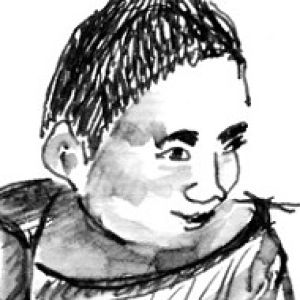Favorite: Saints in the age of photography
The DDW May challenge for Day 29 is "Favorite."
Here are a few of my favorite saints: three canonized by the Church and two known only to a few.
I chose to share these images with you because unlike the millennia of saints before them, these saints lived in the age of photography. Did you know that there are no descriptions of Jesus, his parents, or any of his disciples in the Bible? Traditional depictions developed over the centuries - St. Joseph old, St. Peter a burly fisherman - but we don't know what they looked like. But I have photographs of these favorite saints of mine. Allow me to introduce them. (For further information, I refer you to Bishop Google.)
The large framed portrait of a young nun is St. Thérèse of Lisieux, affectionately known as the Little Flower, formally known as St. Thérèse of the Child Jesus and the Holy Face. She entered a Carmelite convent at 15 and died at 24, yet she is fulfilling her desire to be a missionary and her relics have traveled around the world. The smaller cards to the right show her as a young girl and as a nun. Despite her youth, she was made a Doctor of the Church for her writing: poems, songs, plays, and memoirs. She was also an artist. She is known for her simple, child-like devotion to the Holy Family. She expressed her intention this way: "In the heart of the Church I will be love."
Inset in the portrait of St. Thérèse is a photograph of Brother André Bessette, now St. André of Montreal. Though poor, sickly, and uneducated, he managed to become a member of a great teaching order, the Congregation of Holy Cross, where he was considered unfit for any work but the job of porter. He stood at the door and greeted people. Those who were greeted by Brother André began to report that his ministrations and counsel had healed them. He was beloved by both the poor and the rich; the latter helped him fulfill his dream of building a great monument to his favorite saint, St. Joseph: St. Joseph's Oratory in Montreal, the largest church in Canada, where one wall is covered with the crutches and medical devices of people who sought the help of Brother André and were healed of their infirmities.
Padre Pio, now known as St. Pio of Pietrelcina, was a Capuchin friar in Italy who is known for many miracles including not only healings but bilocation - on more than one occasion he was documented as having been seen in two places at the same time. He received the stigmata, the wounds of Christ, in his hands and feet and suffered great pain for much of his life. He was a simple man, a great confessor and spiritual director, and an irritant to the powers that be in the Church.
"Full many a gem of purest ray serene
The dark unfathom'd caves of ocean bear:
Full many a flower is born to blush unseen,
And waste its sweetness on the desert air."
--Thomas Gray, "Elegy in a Country Churchyard"
May I introduce you to two friends of mine?
Fr. Desmond Francis O'Brien, S.J., the smiling leprechaun next to Padre Pio, came from a large and very poor family in Ireland. Like many young men of such circumstances, he found the Church a means of escaping ignorance and poverty and joined the Jesuit order. He was sent to Central Africa as a missionary and spent most of his life in Zambia until a final illness returned him to Dublin. I met him in a class at the Jesuit School of Theology in Berkeley, California, when he was on a year's sabbatical, and we became friends. I think we astonished each other. I'd never met anyone like him, and he'd never met anyone like me. When Des returned to Africa we continued to correspond for a quarter of a century, until his death. He worked very hard as a priest, teacher, and spiritual director, in difficult conditions, selflessly giving of himself to the people he'd been called to serve. This photograph, from his funeral mass, was sent to me by his sister. The framed Madonna and Child at the bottom of the array is a card sent to me by Des from Zambia.
Last but not least, Tosca Maria Massoni was a Sister in the Daughters of Charity for most of her life, though she left the order for painful reasons never disclosed to me. She was a mathematician, teacher, principal, and superintendent of schools for her order. I hired her as an administrative assistant in a Silicon Valley company, and we were friends until her death (only a few months after Des O'Brien's). Because I was unable to attend her funeral, a friar friend offered to go in my place; he reported that this modest and self-effacing woman was honored that day by the presence of over 700 people. The little holy water vial to the left of St. Thérèse is a reliquary of Maria.
Catholics believe in the communion of saints, which includes not only the Church's official heroes of the faith, recognized for their heroic virtue, but all our beloved dead. We believe that they are present with us as we worship. I knew Des and Maria as ordinary friends, but Padre Pio and St. Thérèse and Brother André have also become my friends. And just as we treasure photos of people we love, I'm happy to have these and happy to share them.
Worth looking at large.
-----------------------------------
I decided I liked this better in b&w.
- 0
- 0
- Apple iPhone 4S
- 1/33
- f/2.4
- 4mm
- 64

Comments
Sign in or get an account to comment.


